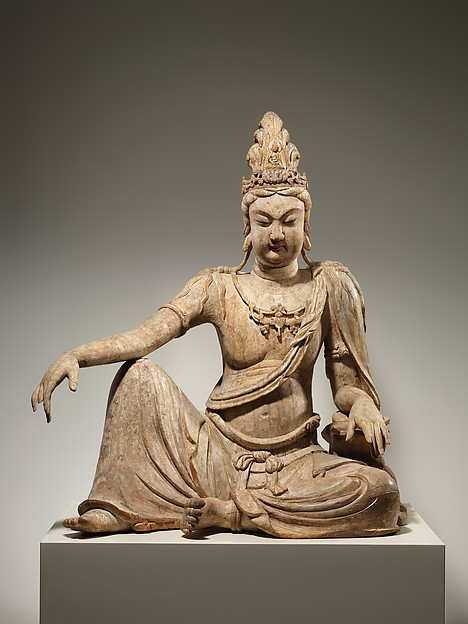
Avalokitesvara Bodhisattva
when practicing deeply
the Prajna Paramita
perceives that all five
skandhas are empty
and is saved
from all suffering
and distress.
Shariputra,
form does not differ from emptiness,
form does not differ from emptiness,
emptiness does not
differ from form.
That which is
form is emptiness,
that which is
emptiness form.
The same is
true of feelings,
perceptions, impulses,
consciousness.
Shariputra,
all dharmas are marked with emptiness;
all dharmas are marked with emptiness;
they do not appear or
disappear,
are not tainted
or pure,
do not increase
or decrease.
Therefore, in emptiness no form,
no feelings,
perceptions, impulses,
consciousness.
No eyes, no ears, no nose, no tongue, no body, no mind;
no color, no sound, no smell, no taste, no touch,
no object of
mind;
no realm of
eyes
and so forth
until no realm
of mind consciousness.
No ignorance and also
no extinction of it,
and so forth
until no old age and
death
and also no
extinction of them.
No suffering, no origination,
no stopping, no path, no cognition,
also no attainment
with nothing to attain.
The Bodhisattva depends on Prajna
Paramita
and the mind
is no hindrance;
without any hindrance
no fears exist.
Far apart from
every perverted view one
dwells in Nirvana.
In the three worlds
all Buddhas depend on
Prajna Paramita
and attain Anuttara
Samyak Sambodhi.
Therefore know that
Prajna Paramita
is the great
transcendent mantra,
is the great
bright mantra,
is the utmost
mantra,
is the supreme
mantra
which is able
to relieve all suffering
and is true,
not false.
Statement - Form
does not differ from emptiness, emptiness does not differ from form. Form is
emptiness, emptiness is form.
Understanding - When
you perceive a form or see a form it is an illusion and is like a mirage
created by our mind. However when you attain that emptiness then also the mind
creates a form appropriate for that emptiness. Therefore one is caught in a vicious
circle.
Statement - No
appearing, no disappearing. No taint, no purity. No increase, no decrease.
Understanding - This
line points right to the fact that, in our original nature, nothing ever
appears or disappears. There is no such thing as taint or purity, because these
are merely qualities created by the thinking-mind. And in original nature there
is neither increase nor decrease. Our true nature is completely still and
empty. It is the universal substance of which everything else is composed. How,
then, could it ever appear or disappear, or be tainted or pure? More
importantly, since our true nature is the same as the universe, how could it
ever increase or decrease? Infinite in time and space, it has none of the
characteristics that apply to things we can describe with speech and words.
Statement - All
dharmas are marked with emptiness. No cognition, no attainment. Nirvana.
Understanding - The
Four Noble Truths and the Eightfold Path of Hinayana reflect a path which
perceives that everything is suffering, and which then leads to stopping
suffering, stopping birth and death. This is nirvana. There are no opposites:
no coming or going, no high or low, good or bad, birth or death. So in the true
experience of emptiness, you perceive that there is already no birth or death,
no coming or going. How can you stop something that doesn’t even exist? There
is already no suffering: how can it have an origin, and how can it possibly be
extinguished? That is why the Heart Sutra talks about “no suffering, no
origination, no stopping, no path.” It completely “hits” the opposites-thinking
of the Four Noble Truths that there is suffering, and an origination of it, and
a stopping of it, and a path. So Mahayana Buddhism teaches that there is one
more step from Hinayana teaching. If you only stop at this point, at complete
emptiness, you only attain nirvana. Mahayana Buddhism’s view means taking
another step.
Statement - Anuttara
samyak sambodhi.
Understanding - Anuttara
samyak sambodhi is a Sanskrit phrase meaning “unexcelled perfect
enlightenment.” It is simply another way of saying “truth.” When you see, when
you hear, when you smell, when you taste, when you touch, when you think -
everything, just-like-this, is the truth. Before, just at the point of nirvana,
there is no cognition, and no attainment with nothing to attain. So the
bodhisattva depends on Prajna Paramita, and attains nirvana. But then these
three words appear: anuttara samyak sambodhi. Before, there is no attainment;
now, all Buddhas attain anuttara samyak sambodhi. What does this mean?
If you just attain true
emptiness, this is only nirvana. It is an experience of complete stillness and
bliss: there is no subject or object, no good or bad, no coming or going, no
life or death. There is nothing to attain. But Mahayana means your practice
continues “beyond” this point, so that you attain no-attainment. You must find
nirvana’s function in the world. The name for that is unexcelled perfect
enlightenment. If you attain no-attainment, then you attain truth. Your mind is
empty and clear like space. This means your mind is clear like a mirror: If a
mountain appears before the mirror, there is only mountain; water appears, and
there is only water; red comes, red; white comes, white. The sky is blue. The
tree is green. A dog is barking, “Woof! Woof!” Sugar is sweet. Everything that
you see, hear, smell, taste, touch, and think is the truth, just as it is.
Nirvana means attaining emptiness, which has nothing to attain. Anuttara samyak
sambodhi means using the experience of emptiness to attain truth. With an empty
mind, reflect this world, just as it is. That is Mahayana Buddhism and the
Great Bodhisattva Way.
No comments:
Post a Comment